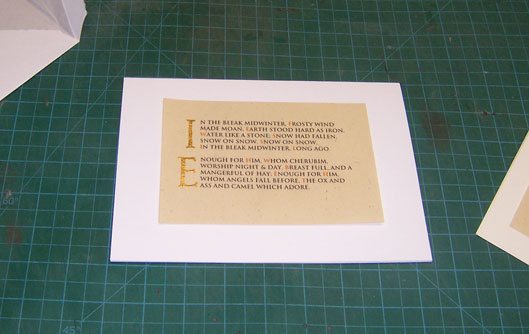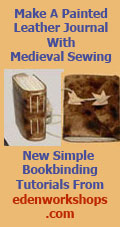How To Create Your Own Gilded ManuscriptThis project brings together a refreshingly simple method of gilding onto paper with an even simpler method of making an imitation vellum, to create a convincing gilded manuscript. If you just wish to know how to gild onto paper ignore the last stage of the four steps mentioned further down the page.
The paper you choose for this project is important. Bookbinders knew a great deal about paper and chose those papers most suited for what they were trying to achieve. There are many suitable papers, almost any hand made, or mould made paper of about 175gsm in wieght and off white to cream in colour will do. A good choice would be a good quality heavy cartridge paper, we used this a lot.
This is what you need; An inkjet printer, “Word” software or similar.A good quality paper to print onto. The paper you use is important, best to consult an art supply shop where good quality papers are commonplace. A 200gsm cartridge would be fine for this project.Imitation gold leaf, you can use 23 carat gold leaf, but after you have applied the finish to the gilded manuscript it will be hard to tell them apart.Gold size or adhesive, I have developed my own gold size after extensive experiments with traditional and modern gold sizes. The size I supply is called“Simple Scribe” it is available from the gold lead supplies page
A small amount of blonde de waxed shellac. This is going to be the basis of our gilded manuscript finish, it is important to get this type of shellac by name; it is the right tint for what we are looking for.
Methylated Spirit is needed to dissolve the shellac, this is a 90% proof alcohol made to smell and taste bad, in America it is known as denatured alcohol.
Some small paint brushes and one larger one for applying the imitation vellum finish to the whole sheet of paper.
Lastly you will need a pair of scissors, a scalpel, or craft knife, a steel ruler and a cutting mat or sheet of waste card to cut upon, and a little masking tape.
This gilded manuscript project can be broken up into four steps.
1. The printing
2. Applying the gold adhesive
3. Applying the gold metal leaf.
4. Applying the imitation vellum finish.
The Printing
OK, the first thing to do is set up what you want to print in a Word Document, make sure that you are set to print an A4 document
You will notice the capitals of the gilded manuscript are printed in pale pink. This enables me to see the areas I have to apply gold adhesive to.
Applying the gold adhesive.
Do not apply to much adhesive, we don’t want to form a high bead with the liquid size forming a domed effect. Rather, give the letter two thin coats.
Now leave to dry completely, say half an hour in a warm room and don’t worry, remember the gold size dries sticky, you can do the gilding right away or weeks later if you want, but dust may be a problem if you do wait that long.
Try to resist the temptation to touch the dry but sticky adhesive, it is very sticky and touching it will disturb the surface of the adhesive.
Applying the gold metal leaf.
If you have not gilded before don’t worry, imitation gold leaf is much thicker than 23 carat gold leaf which makes it much easier to handle, you can even handle the leaf with your fingers if they are dry and grease free.
Take the book of metal leaf and remove one sheet of gold sandwiched between two sheets of tissue, I have found it easy to tear the three layers straight from the book of leaf, grip the sandwich firmly and gently tear out.
I have to say it would be a little easier if I had some patent gold leaf, it being mounted on a thin sheet of paper and in this one respect easier to use than loose leaf, but as you can see from the pictures it is not difficult to handle the leaf.
Cut the sandwich according to the size pieces you need.
Lay the leaf down flat over the area to be gilded and smooth the paper down flat.
You can now rub down firmly with the tissue still in place; in effect this is burnishing the leaf, so rub down well.
Tear of a piece of masking tape 2 or 3 inches long.
Using a gentle dabbing action work your way over the leaf, as soon as the tape has picked up leaf move on to an unused part of the tape. If you use the masking tape too aggresively you may remove the gold.
Applying the imitation vellum finish.
As I have said, bookbinders in the past used to produce imitation vellum and parchment by varnishing certain types of suitable paper.
We are going to do the same thing. What makes this so much fun is the difference applying shellac is going to do to the paper.
The shellac is mixed up 1 part of shellac to four parts of methylated spirit/denatured alcohol.
Place the shellac in a glass jar with a screw top, add the alcohol and shake occasionally over a 48 hour period.
The alcohol does give off fumes so work in a room that has good ventilation if they bother you.
It colours the gold slightly giving it a deeper hue; it also seals the leaf so it will not tarnish.
It also changes the colour of the paper as well as hardening it, making it more like vellum in the way it handles.
It changes the appearance of the paper, making it slightly translucent, the thinner the paper the more translucent.
It also alters the tint of the paper considerably. It also increases the surface abrasion characteristics, making it more like vellum, it is also quite stiff by virtue of the shellac which now permeates the whole of the paper, again just like genuine vellum
Let the print dry in a warm room.
And that is the end of the process.
So you see, it's quite straight forward to create this convincing gilded manuscript. However there are other things you can do with this method.
You can also make inexpensive bespoke seasonal cards that look both hand made and attractive.
You use the same process as used to make the gilded manuscript.
I happen to be working with Christmas themes in these examples, but you can use this method for any occasion.
This is the first two verses of “In the bleak mid winter” with gilded capitals.
Any stationers should be able to supply you with matching blank cards and envelopes.
You can purchase the whole gilded manuscript kit, which is enough for 5 A4 projects or 15/20 average sized seasonal cards from the gilding kits page.
The manual for this project can be found at the download page.
So far we have looked at imitation gold leaf in a craft context, but their are people who are using gold metal leaf in their work as artists. Take a look at what can be done when imitation gold leaf becomes gold leaf art.
EVERY MONTH I SEND OUT A NEWSLETTER WHICH AIMS TO BRING YOU INTERESTING ITEMS CONCERNING THE WORLD OF GILDING AND RELATED CRAFTS. IF YOU WOULD CARE TO SUBSCRIBE PLEASE JUST MAIL Richard at [email protected] and put "gold-vault" in the subject box. |
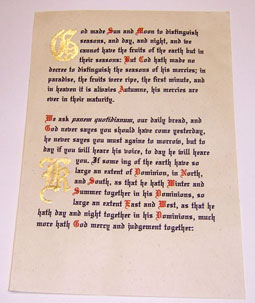 Generations of bookbinders have
known how to make their own imitation vellums,
having as their ideal the medieval gilded
manuscript.
Generations of bookbinders have
known how to make their own imitation vellums,
having as their ideal the medieval gilded
manuscript. For those who
don’t know, you can insert a large capital like I have
done by highlighting the letter you want to capitalize and
in Word go to Format/Drop Cap/Dropped, and enter the
number of lines you want the capital to extend, in effect
this determines the size of the capital and arranges all
the text around it.
For those who
don’t know, you can insert a large capital like I have
done by highlighting the letter you want to capitalize and
in Word go to Format/Drop Cap/Dropped, and enter the
number of lines you want the capital to extend, in effect
this determines the size of the capital and arranges all
the text around it.
 Now lay the
sandwich onto your cutting mat or waste
card.
Now lay the
sandwich onto your cutting mat or waste
card.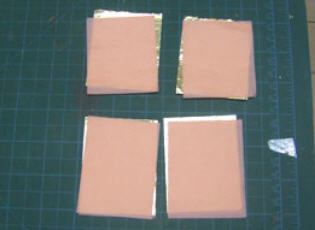 In this
case I am going to cut the leaf into quarters as this size
suits the capitals I am going to gild.
In this
case I am going to cut the leaf into quarters as this size
suits the capitals I am going to gild. Remove one
sheet of tissue from one of the pieces and lay the leaf
down over the capital to be gilded keeping the top piece
of tissue in place.
Remove one
sheet of tissue from one of the pieces and lay the leaf
down over the capital to be gilded keeping the top piece
of tissue in place.
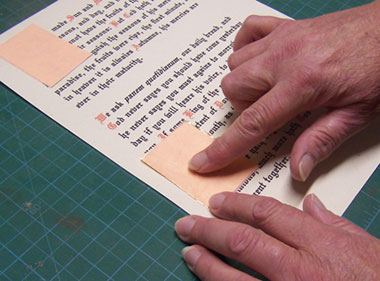
 Now
we want to remove all the surplus leaf which will reveal
the letter we have gilded.
Now
we want to remove all the surplus leaf which will reveal
the letter we have gilded.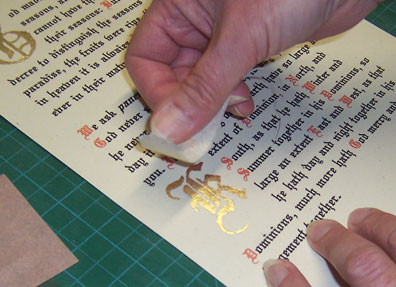 This
works because the gold adhesive is stickier than the
masking tape.
This
works because the gold adhesive is stickier than the
masking tape. Just paint
the shellac on, doing so does several
things.
Just paint
the shellac on, doing so does several
things.
